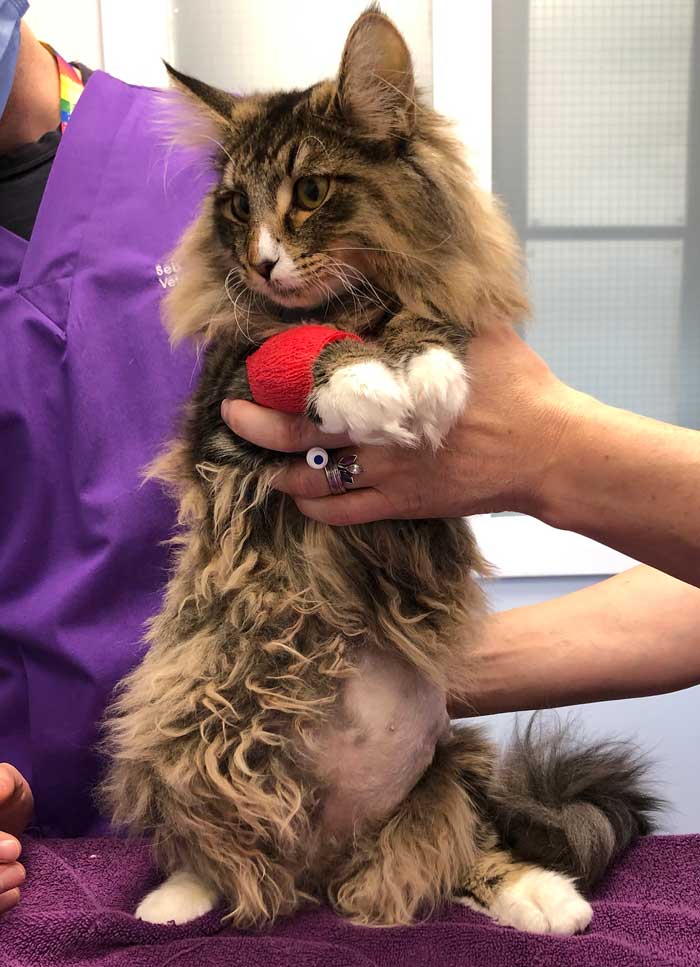1 Feb 2022


Figure 1. Oral GS-441524 tablets.
In August 2021 remdesivir became legally available to UK vets for the treatment of FIP in cats. Since that time many cats and kittens have been treated and are still being treated successfully.
As with any novel formulation, with experience, adjustments are made in protocols and given the recent release (November 2021) of oral GS-441524 (50mg tablets) from a specials manufacturer in the UK (Figure 1), this article has been created to support practitioners in the use of remdesivir and GS-441524 in the management of FIP.
It is worth remembering that treatment may need to be tailored to the individual cat based on response, compliance and client finances. Specific protocols are listed to help vets make decisions with their clients, but will not be appropriate for all.
Drug dosages have increased from previous recommendations, based on the experience of our Australian colleagues who have treated more than 600 cats.
Although some cats responded to the previously recommended lower dosages, they found that recurrence at, or towards the end of, the 84-day (12-week) treatment period was possible, resulting in the need for extension of the treatment at a higher daily dosage. This was ultimately more expensive than if the treatment course had been started at a higher dosage.
When using remdesivir and/or GS-441524, treatment options now include a 12-week course of injectable remdesivir, transition from injectable remdesivir to oral GS-441524 or an entirely oral GS-441524 protocol. Suggested dosages, benefits and limitations of each protocol are provided further on.
Remdesivir cannot be given orally. Recommended drug dosages (Table 1) depend on clinical presentation – that is, whether an effusion is present and whether ocular and/or neurological involvement exists. This is due to variation in the tissue penetration of the drugs. Where doubt exists, use of the higher dosage is preferable.
Please note that these dosages of oral GS-441524 are higher than quoted in some publications – this is because these publications have used “black market” preparations of so-called GS-441524 in which the amount of active agent given to the cats was not confirmed.
The aforementioned provided dosages are based on experience using an oral preparation of known GS-441524 content.
The decision on when to move from injectable remdesivir to oral GS-441524 may depend on the cat’s tolerance of injections (or oral administration of tablets), formulation price differences (including cost of needles, syringes, sharps disposal, wastage), and owner preferences and finances. Experience suggests this transition can be made between 7 and 14 days of starting remdesivir IV or SC treatment.
The protocol chosen will depend on the severity of the FIP disease in the cat. Dosages are shown in Table 1.
| Table 1. Summary of dosage recommendations for remdesivir and GS-441524 | ||
|---|---|---|
| Clinical presentation | Remdesivir – by injection | GS-441524 – oral |
| Cats with effusions and without ocular or neurological signs | 10mg/kg once daily | 10mg/kg to 12mg/kg once daily |
| No effusion and without ocular or neurological signs | 12mg/kg once daily | 10mg/kg to 12mg/kg once daily |
| Ocular signs present (effusive and non-effusive) | 15mg/kg once daily | 15mg/kg once daily |
| Neurological signs present (effusive and non-effusive) | 20mg/kg once daily | 10mg/kg twice daily (that is, 20mg/kg given as a divided dose) |
Regarding severe disease (anorexic, dehydrated, cat usually will be hospitalised):
Regarding less severe disease (normal hydration, eating):
An oral GS-441524 treatment-only protocol is recommended if injectable not tolerated/possible financially:
Remdesivir seems well tolerated. However, the following adverse effects have been reported:
It is very important to weigh cats weekly during treatment, using accurate scales – weight gain and/or growth in kittens will occur with successful treatment necessitating an increase in dose to ensure that the dosage of antiviral administered is still appropriate for the type of FIP being treated.
Please note that, ideally, therapy should be given using the recommended formulations and dosages for as long as possible (up to 84 days) to increase likelihood of cure.
Only take the following options listed below if absolutely necessary, as relapse may occur, which then requires longer treatment, increasing costs:
Regarding whether oral treatments are given with or without food:
Do not forget to support clients giving oral medications, as this can also be challenging. Direct clients to the International Cat Care website for information.
International Cat Care has also produced two demonstration videos – one showing two people giving a tablet:
…the other showing the use of a pill popper:
Injection with remdesivir can cause transient local discomfort. The following may help reduce discomfort and improve compliance:
During treatment:

What do I need to monitor during treatment?
The following should be monitored during treatment:
Regarding when to stop treatment if you are seeing a positive response to treatment:
If you are seeing no response or only a partial response to treatment:
Regarding what to monitor after treatment:
In the event of relapse – for example, recurrence of effusion, pyrexia, development of ocular or neurological signs, or return of hyperglobulinaemia:
We are constantly learning about treatment with these drugs and advice may change in time. Other agents – for example, protease inhibitors (such as GC374) and other nucleoside analogues (such as molpurinavir) have also been trialled in cats, but are not commercially available at this time. How these agents and other immunomodulatory agents (such as polyprenyl immunostimulant) will fit into a future protocols is unknown at this time.
Thank you to Richard Malik and Sally Coggins for their advice in producing this article.
The authors have come together to run the FIP advice email address answering queries on the new treatments on a voluntary basis, and disseminating information to vets and vet nurses in the UK. So far they have answered more than 150 emails on the advice line.
